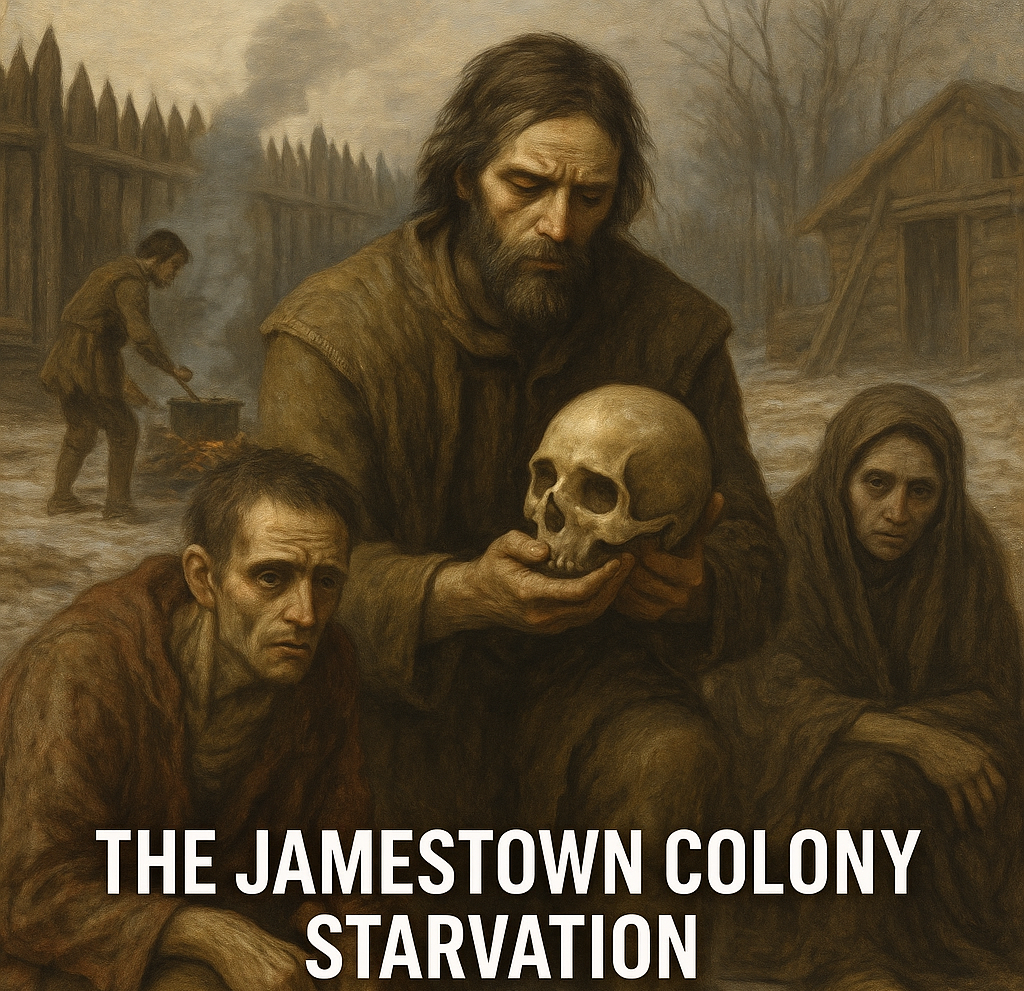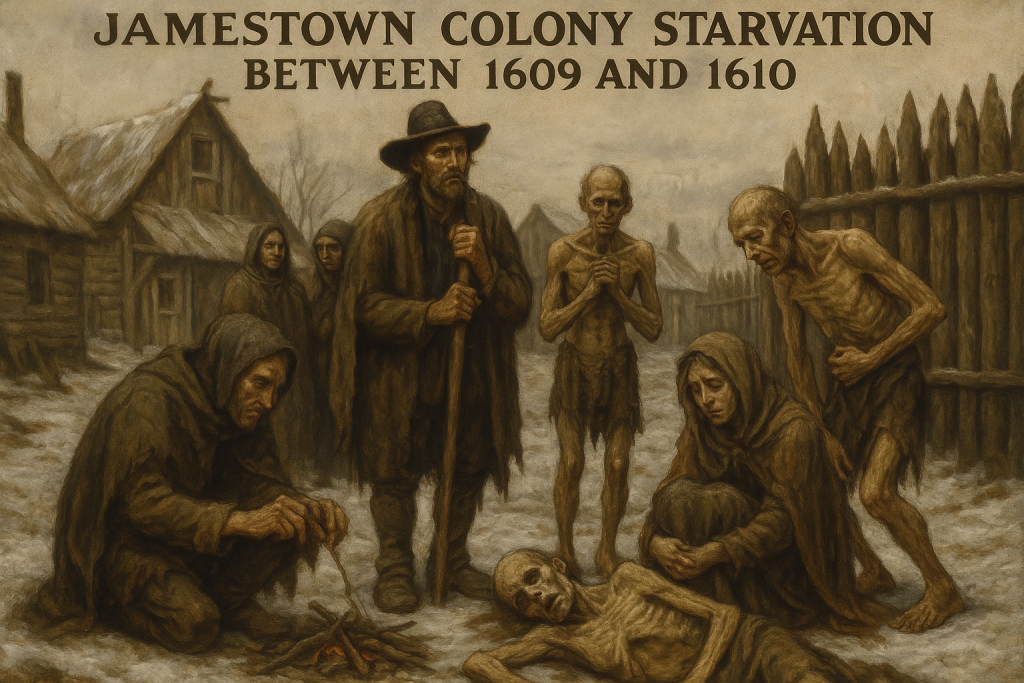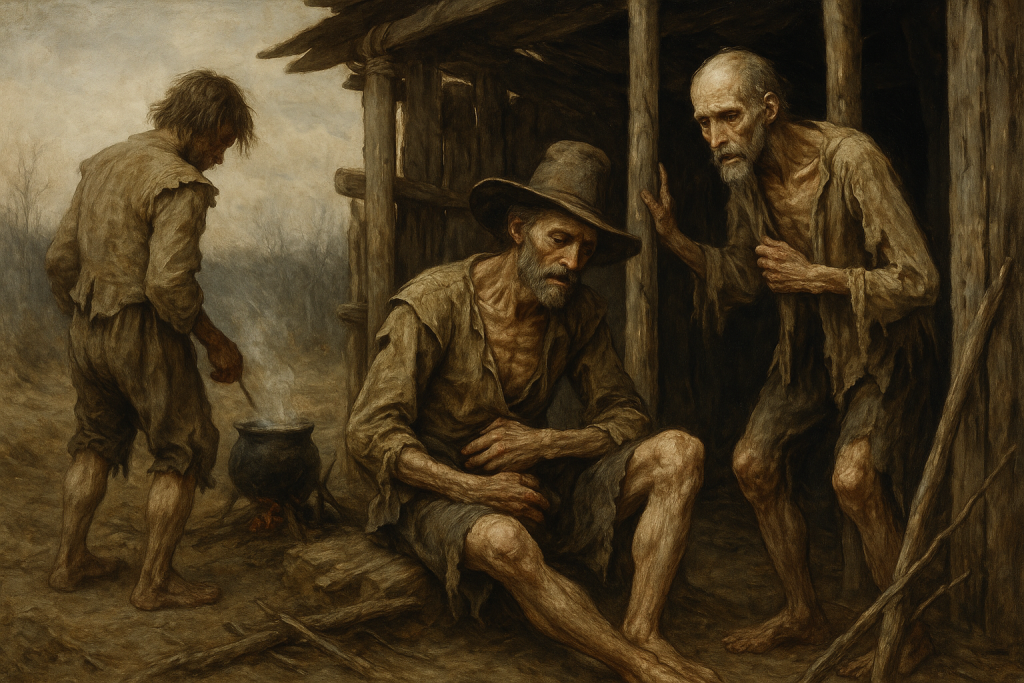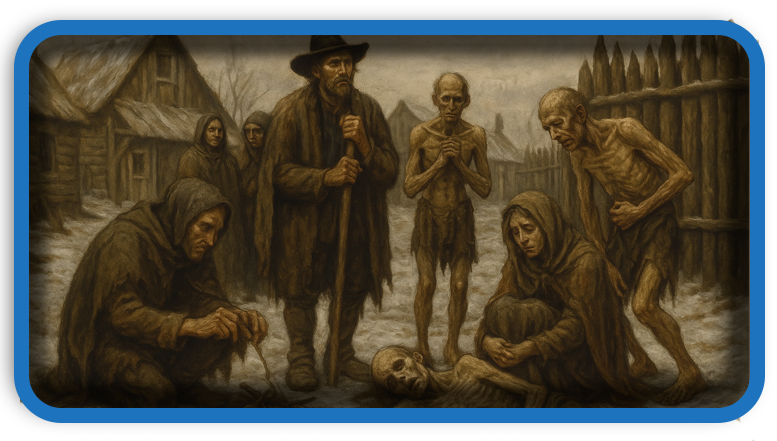⏲️ Estimated reading time: 5 min
Jamestown Colony Starvation (1609–1610). Between 1609 and 1610, the Jamestown Colony in Virginia experienced a horrific period known as the “Starving Time.” Plagued by famine, disease, and conflict, settlers were pushed to the brink of survival resorting to extreme and tragic measures.
The Jamestown Colony Starvation (United States, 1609–1610)
Introduction to America’s First Permanent English Settlement
In 1607, the Virginia Company of London established Jamestown, the first permanent English settlement in North America. Located on the banks of the James River in what is now Virginia, the colony faced hardships from the start. Poor planning, hostile relations with Indigenous peoples, disease, and lack of food created a fragile foundation. However, nothing compared to what came just two years later the deadly and infamous “Starving Time” during the winter of 1609–1610.

The Context: Ambitions and Miscalculations
The English colonists arrived in Jamestown with dreams of wealth and opportunity. Yet they were largely unprepared for the environment. The land was swampy, the water was brackish, and the settlers lacked essential survival skills. Rather than farmers and builders, many were gentlemen untrained in hard labor. Reliance on sporadic supply ships from England and uneasy trade with the Powhatan Confederacy left the colony vulnerable.
In 1609, the largest fleet yet the Third Supply mission set sail with hundreds of new settlers. However, one of the ships, the Sea Venture, wrecked in Bermuda, delaying much-needed supplies. Meanwhile, a new governor, Sir Thomas Gates, was stranded and would not arrive until spring 1610. Back in Jamestown, chaos set in.
The Starving Time Begins
As winter approached in late 1609, tensions with the Powhatan people escalated into open warfare, cutting off trade. Crops failed, and supply lines collapsed. The 300–400 colonists remaining in Jamestown found themselves isolated and under siege, unable to leave the fort without facing death.
Then the “Starving Time” truly began.
By all accounts, the winter was catastrophic. Eyewitnesses describe horrific scenes: colonists digging up graves to eat corpses, boiling leather from shoes and belts, consuming rats, dogs, and horses and even turning to cannibalism.
In one documented case, a man was executed for killing and eating his wife. According to reports from the time, he had murdered her and salted her flesh for later consumption.

Firsthand Accounts of Desperation
The accounts of this period are harrowing. George Percy, acting governor during this time, wrote:
“Now all of us at James Town beginning to feel that sharp prick of hunger… we did eat dogs, cats, rats, and mice… and then dug up dead corpses out of graves to eat them.”
Such was the level of suffering that out of the original 500 colonists who entered winter in 1609, only 60 survived to see spring.
The Arrival of Salvation
In May 1610, Sir Thomas Gates finally arrived from Bermuda, only to find a skeletal colony on the verge of abandonment. So few people remained that the leaders decided to sail back to England. As fate would have it, just as they departed down the James River, Lord De La Warr arrived with fresh supplies and new settlers, ordering the group to return to Jamestown.
This fortuitous moment saved the colony from total collapse.
The Legacy of the Starving Time
The Jamestown Starvation period remains one of the darkest chapters in early American history. It highlights the fragility of early European colonies, the consequences of poor planning, and the brutal reality of survival in the New World.
While the colony did recover and grow with the introduction of tobacco farming and more structured governance Jamestown’s early years were marked by extreme suffering. Archaeological digs in recent decades have unearthed physical evidence of the starvation, including butcher marks on human bones that support the written accounts of cannibalism.
What We Learned from Jamestown’s Struggles
The Starving Time is not just a historical curiosity it is a reminder of the importance of:
- Adaptability: Success in a new environment requires more than ambition.
- Respect for Native populations: Early hostility sowed long-term conflict.
- Leadership: Lack of direction and coordination contributed to disaster.
- Preparedness: Sending settlers without skills or resources is a recipe for collapse.
Cannibalism: A Last Resort for Survival
The most chilling aspect of the Starving Time is the evidence of cannibalism, a taboo rarely mentioned in colonial histories. Recent studies by Smithsonian archaeologists uncovered remains of a 14-year-old girl dubbed “Jane” whose bones showed clear marks of butchery. The findings confirmed that at least one case of survival cannibalism took place.
This horrifying discovery underscores how desperate life had become. Cannibalism was never part of the settlers’ plan it was a final, awful response to circumstances beyond their control.

Aftermath and the Path Forward
After 1610, the English reorganized Jamestown, implementing military rule, enforcing labor, and rebuilding relations with local unions. John Rolfe’s successful introduction of tobacco as a cash crop eventually made Jamestown profitable, attracting new settlers and investment.
By 1619, Jamestown hosted the first elected legislative assembly in the New World the House of Burgesses laying the groundwork for democratic governance in America.
Still, the shadow of 1609–1610 remained a cautionary tale of hardship, hubris, and human endurance.
🔔For more tutorials like this, consider subscribing to our blog.
📩 Do you have questions or suggestions? Leave a comment or contact us!
🏷️ Tags: Jamestown Colony, American History, Starving Time, Cannibalism in History, Colonial America, Powhatan Confederacy, Virginia History, George Percy, Survival Stories, Archaeological Discoveries
📢 Hashtags: #JamestownColony #StarvingTime #AmericanHistory #Cannibalism #ColonialAmerica #1609 #VirginiaHistory #SurvivalStories #EarlySettlements #USHistory
Final Reflection
The story of Jamestown’s Starving Time is more than a tale of hunger it is a brutal lesson about humanity’s limits, both in endurance and morality. That a group of settlers sent to establish civilization would descend into cannibalism shows just how vulnerable humans can be when left without support, leadership, or compassion.
This dark chapter in American history also illuminates the path forward. Out of unimaginable hardship, Jamestown endured and evolved becoming a cornerstone of what would eventually become the United States.
Understanding the past with all its uncomfortable truths gives depth to our present and helps us shape a better future.
Only logged-in users can submit reports.
Discover more from HelpZone
Subscribe to get the latest posts sent to your email.

